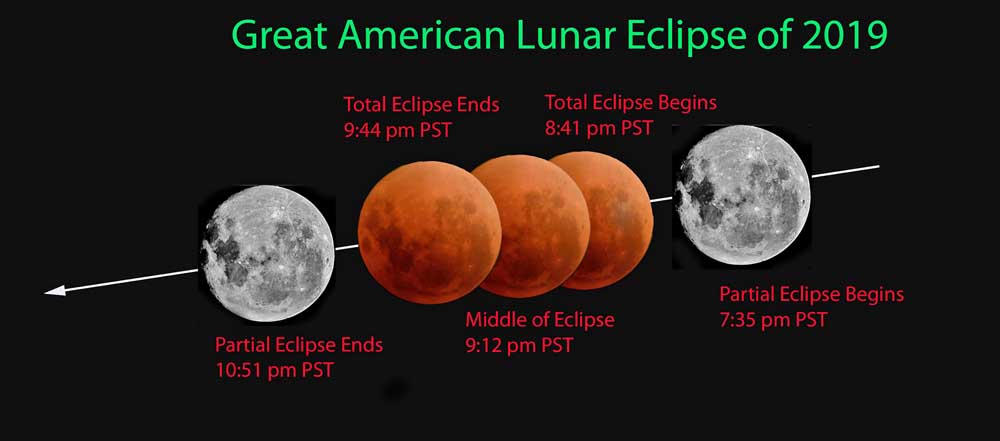It’s a total eclipse of the moon
Published 9:28 am Thursday, January 10, 2019

- If we luck out and the evening is clear, Pacific Northwest residents are in for one of nature’s great shows on Jan. 20.
The Great American Eclipse is coming!
Again. On Jan. 20, our Earth, moon and the sun once again align, but this time it is the moon that gets the shadow, and we get a total lunar eclipse. And unlike the 2017 solar eclipse, an optimal viewing location is already guaranteed. For this eclipse, not a single person in the Pacific Northwest will have to travel farther than their backyard to view it.
Not only will West Coast watchers be treated to a complete eclipse, from beginning to end, between sunset and midnight, but the entire western hemisphere, from Tierra del Fuego at the southern tip of our continents to Point Barrow, Alaska, and from Oysterville to Boston, and all points between, will enjoy the eclipse in its entirety. And a special, spectacular one it will be.
An astronaut on the moon would see Earth surrounded by a thin, red ring of sunlight, shining through the atmosphere. He would be observing every sunrise and sunset on Earth happening simultaneously.
The winter sun resides below the celestial equator and barely rises above the southern horizon for us viewers in the northern climes. But the full moon, always positioned opposite the sun, occupies a place in the heavens reserved for the sun in summer; brilliantly high in the sky. The full moon is an imposing sight in January as it bathes the land in reflected sunlight, brilliant enough to cast shadows. But from 8:41 p.m. to 9:44 p.m. on the 20th, its brilliance will fade to a dull reddish hue, that some folks like to call the “blood moon.”
Here’s what to look for:
The Great Solar Eclipse of 2017 added the words penumbra and umbra to our vocabulary. As a refresher, the penumbra is the portion of shadow cast before the partial phase begins. It is nearly imperceptible, but by 7:10 p.m. some dimming may be seen. The moon begins to enter the umbra at 7:34 as the partial phase begins. A little more than an hour later the earth’s umbral shadow will completely immerse the moon. Totality will last another hour before the process is reversed, and the moon begins to return to its normal brilliance. The entire show ends at 11:50 p.m. when the moon leaves the penumbra.
That blood moon
Amateur and professional astronomers are not looking for blood on the moon, but are nevertheless interested in the color and intensity of the light that makes its way around the Earth to illuminate the lunar disc, and it can be of more than a passing interest to the casual observer. The appearance of a full lunar eclipse gives us a glimpse into the condition of the atmosphere surrounding our planet. The only reason we can see the moon at all during an eclipse is because sunlight is refracted and scattered by the Earth’s atmosphere. An astronaut on the moon would see Earth surrounded by a thin, red ring of sunlight, shining through the atmosphere. He would be observing every sunrise and sunset on Earth happening simultaneously.
When the atmosphere is full of clouds and volcanic dust, little light falls on the moon and it will appear very dark, or disappear nearly completely, as in 1963, 1982 and ‘91. Multiple volcanic eruptions during those years dimmed the eclipse. Atmospheric pollutants, while not blocking sunlight, can make for a brilliant, red appearance.
Stars and more stars
Keep an eye on the surrounding night sky before and during the eclipse. Full moonlight in January is pervasive and obscures the night sky better than all of our man-made light pollution. But we just might make out Castor and Pollux, the Gemini Twins, just above the moon. Bright Proycon lies below and to the right, but nearly drowned out by moonlight. The constellation Orion and it’s retinue of brilliant stars lies to the west, barely visible. Totality changes all that.
It’s time to grab the binoculars because when the moon slips away, the stars come out to play. The January night sky is glorious on a moonless night. Orion dominates above the southern horizon. Train the binoculars on the three belt stars and scan below them to the Orion nebula. Scan below the dimmed moon to find the Beehive, a delightful cluster of tiny star points. No need to hurry; the sky will remain dark for a little more than an hour. And then the moon will slowly return to its full glory.
The next total lunar eclipse visible in its entirety from the Pacific Northwest will occur on May 26, 2021.








